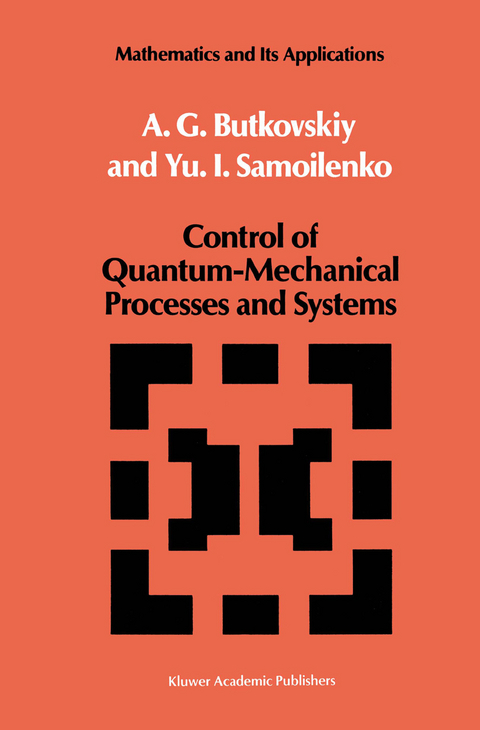
Control of Quantum-Mechanical Processes and Systems
Springer (Verlag)
978-94-010-7392-9 (ISBN)
1. The Problem of Control on the Quantum Level.- 1.1. Introduction.- 1.2. A Quantum Process as the Object of Control.- 1.3. Problems of Control in Different Descriptions.- 1.4. Obtaining a Prescribed Pure State or a State in its Vicinity.- 1.5. Control with the Aim of Obtaining a Specified Probability of a Given Pure State.- 1.6. Obtaining the Maximum (or Minimum) Probability of a Specified Value of a Physical Quantity.- 1.7. Obtaining a Desired Distribution of Probability Amplitudes for Values of Given Physical Quantities.- 1.8. Control of Quantum Averages and Moments of Physical Quantities.- 1.9. Control of the Distributions of Eigenvalues of Physical Quantities.- 1.10. Control of Operators of Physical Quantities.- 1.11. Measurement in Systems with Feedback.- 2. Controllability and Finite Control of Quantum Processes (Analytical Methods).- 2.1. Control of Pure States of Quantum Processes.- 2.2. Local Controllability in the Vicinity of a Pure State.- 2.3. Global Asymptotic Controllability of Pure States.- 2.4. Control of the Electron in a Rectangular Potential Well.- 2.5. Control of a Two-Spin System.- 2.6. Finite Control of a Particle Spin State.- 2.7. Control of Quantum Averages of Physical Quantities.- 2.8. Control of Coherent States of a One-Dimensional Quantum Oscillator by Means of an External Force.- 2.9. Control of a One-Dimensional Quantum Oscillator by Varying its Eigenfrequency.- 2.10. Obtaining a Specified Probability of a Given State of a Charged Particle by Means of an External Magnetic Field.- 2.11. Control of the State of a Free Particle by an External Force.- 2.12. Control of the Coefficients of Linear Differential Equations Impulse Control.- 2.13. Control of Magnetization.- 3. Controllability and Finite Control (Algebraic Methods).- 3.1. Algebraic Conditions for the Controllability of a Quantum Process.- 3.2. Control on the Motion Groups of Quantum Systems.- 3.3. The Structure of the Algebra of a Quantum System.- 3.4. The Accessible Set of Evolution Matrices.- 3.5. Designing Discrete Automata on Controlled Transitions of Quantum Systems.- 4. Optimal Control of Quantum-Mechanical Processes.- 4.1. General Formulation of the Control Problem for a Quantum Statistical Ensemble.- 4.2. Variational Control Problems.- 4.3. Necessary Conditions for an Extremum.- 4.4. Methods of Solving Boundary Value Optimization Problems.- 4.5. Methods of Direct Optimization on Unitary Groups.- 4.6. Maximization of the Probability of Observing a Given State of a Quantum System.- 5. Dynamical Systems with Stored Energy and Negative Susceptibility.- 5.1. The Effect of Negative Susceptibility of Dynamical Systems and its Applications.- 5.2. Synthesis of Bipolar Circuits with Negative Impedance and Negative Conductivity.- 5.3. Negative Susceptibility in Gyroscopically Related Systems.- 5.4. Transverse Susceptibility of a Rigid Dipole in an Inversely Directed Constant Field.- 5.5. Negative Susceptibility of a Parametrically Modulated Oscillator.- 5.6. Systems with Stored Energy.- 5.7. Static Susceptibility of Adiabatically Invariant Control Systems.- 5.8. Conditions for Negative Static Susceptibility in Quantum Systems.- 6. Negative Susceptibility in Parametrically Induced Magnetics.- 6.1. Induced Superdiamagnetism and its Application to Distributed Control.- 6.2. Superdiamagnetic States in Inversely Magnetized Ferromagnetic Media.- 6.3. Superdiamagnetism and Parametrically Stimulated Anomalous Gyrotropy.- 6.4. Low-Frequency Susceptibility of a Gyromagnetic Medium.- 6.5. Stability of Spin Waves in Longitudinal Pumping of Ferromagnetic Crystals.-6.6. Applications.- Appendix 1. Mathematical Models of Quantum Processes.- Appendix 2. Controllability and Finite Control of Dynamical Systems.- A2.1. Controllability and Finite Control of Linear Finite-Dimensional Systems.- A2.2. Finite Control of Linear Distributed Systems.- A2.3. A New Differential Geometric Method of Solving the Problems of Finite Control of Non-Linear Finite-Dimensional Dynamical Systems.- Appendix 3. Continuous Media and Controlled Dynamical Systems (CDS’s). The Maximum Principle for Substance Flow. The Laplacian of a CDS.- References.
| Reihe/Serie | Mathematics and its Applications ; 56 | Mathematics and its Applications ; 56 |
|---|---|
| Zusatzinfo | XIV, 232 p. |
| Verlagsort | Dordrecht |
| Sprache | englisch |
| Maße | 155 x 235 mm |
| Themenwelt | Mathematik / Informatik ► Mathematik ► Analysis |
| Naturwissenschaften ► Physik / Astronomie ► Atom- / Kern- / Molekularphysik | |
| Naturwissenschaften ► Physik / Astronomie ► Quantenphysik | |
| ISBN-10 | 94-010-7392-9 / 9401073929 |
| ISBN-13 | 978-94-010-7392-9 / 9789401073929 |
| Zustand | Neuware |
| Haben Sie eine Frage zum Produkt? |
aus dem Bereich


